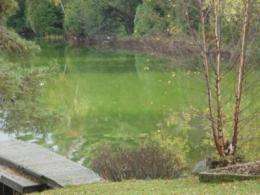Loss of 'lake lawnmowers' leads to algae blooms

Unprecedented algae growth in some lakes could be linked to the decline of water calcium levels and the subsequent loss of an important algae-grazing organism that helps keep blooms at bay.
Daphnia—also known as water fleas—act like microscopic lawnmowers in lakes, feeding on algae and keeping it in check. However, without sufficient calcium, these water fleas cannot reproduce.
"When water calcium levels get low and Daphnia populations decrease in any lake, algal growth goes unchecked and blooms can occur," says lead author and biology doctoral student Jennifer Korosi. "Losing an important grazer like these water fleas has a domino effect that leads to other water quality problems."
Declining calcium concentrations in some lakes, which is linked to acid deposition and logging, has only recently been identified as a serious environmental problem in North America and Europe.
By studying microscopic fossils and other indicators preserved in a lake sediment core from Lake George (Nova Scotia), the Queen's research team found that algal production remained relatively constant throughout the last century until around1990 when the levels tripled. The increase in algae directly coincided with the decrease of Daphnia in the lake.
"Algal blooms appear to be increasing in many lake regions," says biology professor John Smol, Canada Research Chair in Environmental Change, and previous winner of the Natural Sciences and Engineering Research Council of Canada (NSERC) Herzberg Gold Medal as Canada's top scientist. "Decreasing calcium levels appear to be one more factor that can exacerbate this problem. This is particularly worrisome given that many other stressors, such as climate warming and fertilizer runoff, are already contributing to the production of nuisance algal blooms. This is one more nail in the coffin."
Other members of the research team include PhD candidate Joshua Thienpont and undergraduate student Samantha Burke. Funding for the research comes from NSERC.
These findings will be published in the next issue of the prestigious international journal Proceedings of the Royal Society B.
Provided by Queen's University















